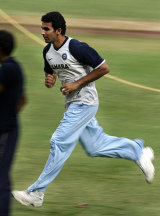Mixed blessings
India's bowling has made decent strides over the course of the year, but there's plenty more work left
06-Nov-2007
|
|

|
India's fast bowling has been up and down over the last three series. Then again, this has been the case over the years. It is only recently that there has been talk, often critical, about this unevenness, because a basic standard has been established.
Zaheer Khan has come back from a layoff stronger than ever before and is being the spearhead he always promised to be. Sreesanth possesses a genuinely threatening outswinger, RP Singh bowls induckers and yorkers seemingly at will, and Irfan Pathan has understood how to make the most of his skills.
If you look at it purely from an Indian perspective, quick bowling is at a high. Unfortunately, when these bowlers come up against the best batting attacks in the world, it's not quite as simple. When India played Australia in a seven-ODI series last month, many shortcomings were laid bare.
Firstly, the euphoria of the win in the ICC World Twenty20 had to be left behind. It was an exhilarating ride, but it was over. Starting on a clean slate, in conditions very different from those in Johannesburg and Durban, India's quick bowlers weren't quite the force they were made out to be. Often the business ends in an ODI are the initial overs, when the Powerplays are on, and the death, when teams have wickets in hand and are willing to go hard at anything thrown at them. India's fast bowlers have been found wanting in these periods. A serious problem has been accuracy. Often the best way to heighten accuracy is to cut down on pace.
Yet, when you suggest to Venkatesh Prasad, India's bowling coach, that his bowlers are pulling back on speed to concentrate on a certain line and length, he disagrees vehemently. "No way, not at all. That's not a fair comment at all. In the last series against Australia everyone was touching 135 and above, including Irfan Pathan," he told Cricinfo. "In fact, I would go a step further and say that our bowlers are the only ones who can swing the ball at 135-140."
Even if you do grant Prasad that, the problem of inconsistency is not one that can be wished away. Against Australia, Sreesanth gave away 6.77 runs an over, and RP Singh was even more expensive. Zaheer hovered just below the six-per-over mark.
"There is no specific work one can do in this regard [consistency]," Prasad said. "What has to be done is to make sure the net sessions are as good as match scenarios, and make the practice more meaningful and purposeful.
"For example, Sreesanth bowls a fantastic outswinger. All he needs to be looking to do is be more disciplined and make the batsman play most of the time. That should be the aim for any fast bowler. You need to come with a goal - say, to get the batsman out caught at slip. To do that you have to be consistently hitting a good line and length on and outside the off stump and getting him to play off the front foot."
The one bowler who has been consistent is Pathan. Although it's unclear whether he has rediscovered the big inswing into the right-hander that made him a tough customer to handle when he first arrived, Pathan has learned what it takes to succeed. He is varying his pace cleverly, rolling his fingers over the ball to bowl cutters more frequently, and in general has not allowed batsmen to settle against him. In most of the games against Australia he was able to break partnerships - even if a couple of wickets came off stumpings, with MS Dhoni standing up to the wicket - and even when he didn't, he dried up the runs, allowing his captain some control over the game.
|
|

|
There's been plenty of theorising over where Pathan went wrong, what needed to be done to correct his flaws, and that sort of thing, with experts from around the world weighing in. But a stint at the MRF Pace Foundation and time spent with Prasad seem to have done the trick.
Prasad put the slump and revival down to mental aspects. "Definitely [it's a mental thing]," he said. "I really appreciate Irfan in this regard. His interaction with me is fantastic. Every time he keeps coming and talking to me about what he did and what he can do... He has understood how it is to be left out of the team so he wants to work that much harder to ensure that he performs and stays in the team. We have also worked on the line, length, and what he needs to be doing when he is bowling a slower ball: where he needs to aim, what line to keep, what length."
One positive over the last few months is that a core group of bowlers has been identified, and all of them are getting matches under their belt. There's also plenty of variety in the styles of delivery, even if three of the operators are left-arm bowlers.
The real test will come when India tour Australia, however. On true pitches that have good bounce and carry, it becomes impossible to hide even one fast bowler, and relying overly on spinners will be a dangerous ploy. Australia's batsmen are brought up on a diet of fast bowling, and any inconsistency, in the course of a five-day game, will be punished. That series will be the true test of the mettle of India's fast bowlers, in terms of skill, execution and mental strength.
Read the full interview with Venkatesh Prasad here
Anand Vasu is an associate editor at Cricinfo